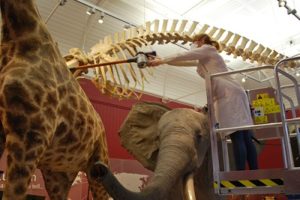An important part of the preparations to reopen RAMM, has been cleaning the building – from top to bottom. This included obvious things such as door handles, railings and floors, but also, objects that are not displayed in cases.
Because objects like Gerald the giraffe and the elephant are not protected by a case, dust easily accumulates on their surface. If left unattended, these dust layers become very thick and can cause several issues.
The perils of dust
Dust layers can attract insect pests that might start nibbling on the object and they can encourage mould growth. Thick dust layers also trap moisture more easily and can trigger chemical reactions. In turn, this may cause damage to the object’s surface (think of rust). And last, but not least, dusty objects don’t look great on display. So there are several reasons why we remove the dust from our objects on open display on a regular basis.

To remove the dust we carefully lift the dirt from the object’s surface with soft brushes and catch it with the nozzle of a vacuum cleaner. This is easier said than done; many of the objects are quite high up or have other objects in front of them. Think of the long walls in our Making History Gallery covered with uncased objects. To reach all the nooks and crannies where dust accumulates, we use a combination of ladders, kick stools, a mobile scaffolding and our mobile lift platform.
It is always astonishing how much dust is actually sitting on an object. Cleaning Gerald and the elephant, for example, made them appear a lot brighter. The colours looked more vibrant, even though they didn’t seem particularly dusty at first glance. We want to make sure that all the objects look their best for our visitors, so all the effort is definitely worth it.
This content is viewable by members only. Login or sign up to get access.

